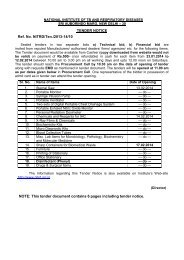The Indian Journal of Tuberculosis - LRS Institute of Tuberculosis ...
The Indian Journal of Tuberculosis - LRS Institute of Tuberculosis ...
The Indian Journal of Tuberculosis - LRS Institute of Tuberculosis ...
Create successful ePaper yourself
Turn your PDF publications into a flip-book with our unique Google optimized e-Paper software.
26 G. RAGHUPATI SARMA ETAL<br />
extrapulmonary tuberculosis) was much less than<br />
that in our series, and this is most probably due to<br />
difference in the definition employed to classify<br />
the patients as positive or negative responders to<br />
tetracosactrin 1 Further, they observed a<br />
significant decrease in plasma cortisol, 3-4 weeks<br />
after the start <strong>of</strong> treatment with a regimen<br />
containing daily Rifampicin in addition to<br />
Isoniazid, Pyrazinamide and Streptomycin,<br />
findings contrary to those reported in our study<br />
and by Scott et al 16 <strong>The</strong> daily regimen employed<br />
by us (R-7) was similar to that used by Barnes et<br />
al 17 , except that Streptomycin was replaced by<br />
Ethambutol, and it seems unlikely that this single<br />
change could be responsible for the different<br />
findings.<br />
Findings in this paper suggest that<br />
Rifampicin, whether administered daily or twiceweekly<br />
exerts a deleterious effect on the<br />
adrenocortical function, in patients with<br />
pulmonary tuberculosis. <strong>The</strong> mechanism <strong>of</strong><br />
action is not clear; the sustained high plasma<br />
cortisol concentrations, even up to 4 weeks in<br />
patients receiving Rifampicin, appear to go<br />
against a mechanism involving a more rapid<br />
systemic clearance <strong>of</strong> this hormone induced by<br />
the drug. Earlier investigations had shown that<br />
dexamethasone causes an appreciable<br />
suppression <strong>of</strong> cortisol levels in patients with<br />
pulmonary tuberculosis 1 And this suggests that<br />
the HPA axis is intact in these patients. As such, a<br />
decrease in plasma cortisol caused by an increase<br />
in its clearance would trigger the release <strong>of</strong><br />
ACTH by the pituitary resulting in an increase in<br />
the secretion <strong>of</strong> cortisol by the adrenal cortex.<br />
Whether formation <strong>of</strong> antibodies to Rifampicin<br />
or other immunological reactions such as the<br />
formation <strong>of</strong> immune complexes involving<br />
mycobacterial antigens precipitated by the rapid<br />
killing <strong>of</strong> the bacteria or the induction <strong>of</strong> autoimmune<br />
antibodies against adrenocortical cells<br />
are responsible, is a matter <strong>of</strong> conjecture. Several<br />
drugs such as procainamide, hydrallazine,<br />
methyldopa and pencillamine have been shown to<br />
induce auto-immune disorders such as systemic<br />
lupus erythematosis, myasthenia gravis,<br />
haemolysis and hepatitis 18 ' and Rifampicin has<br />
been implicated in evoking pemphigus, an autoimmune<br />
disease <strong>of</strong> the skin 19<br />
<strong>The</strong> diurnal rhythm <strong>of</strong> cortisol secretion was<br />
disturbed in the patients with an evening rise in<br />
cortisol levels before the start <strong>of</strong> treatment. <strong>The</strong><br />
immune system is known to modulate adrenal<br />
production <strong>of</strong> glucocorticoids and cortisol, in<br />
turn, has been shown to regulate certain immune<br />
responses. Monokines, particularly interleukin-1,<br />
released by activated monocytes, are known to<br />
stimulate the hypothalamus, the pituitary and the<br />
adrenal cortex 20 ' 21 ' 22 Stimulation <strong>of</strong> hypothalamus<br />
would not only cause an increase in the release <strong>of</strong><br />
CRF, which would ultimately lead to an increase<br />
in the cortisol production, but also <strong>of</strong> certain<br />
other factors such as PGE 2 which cause an<br />
elevation in body-temperature 23 ' An evening rise<br />
in body-temperature is well-established in<br />
patients with tuberculosis, but the association<br />
between the two phenomena pre-supposes a<br />
circadian rhythm in the release <strong>of</strong> monokines<br />
also. <strong>The</strong> existence <strong>of</strong> such a rhythm <strong>of</strong> several<br />
immune responses is now well-recognised. Thus,<br />
cytolytic activity <strong>of</strong> natural killer cells 24 , mitogenic<br />
and antigenic responses 25 ' 26 ' 27 ' 28 , the counts <strong>of</strong><br />
eosinophils and neutrophils 28 and <strong>of</strong> T and B cell<br />
populations <strong>of</strong> human lymphocytes 2930 have been<br />
shown to exhibit a circadian rhythm. <strong>The</strong> maximal<br />
levels <strong>of</strong> T and B cells were attained at midnight<br />
followed by a depression during the day, and Abo<br />
et a I 29 have shown that variations in the cell<br />
counts were inversely related with plasma cortisol<br />
levels in healthy subjects.<br />
<strong>The</strong> diurnal rhythm <strong>of</strong> cortisol secretion had<br />
reverted to a near-normal pattern after 2 months<br />
<strong>of</strong> treatment in all the 3 groups <strong>of</strong> patients.<br />
Response to tetracosactrin was not examined at<br />
this time and whether this also returns to normal<br />
in a majority <strong>of</strong> the patients with continued<br />
treatment with regimens containing Rifampicin<br />
remains to be investigated.<br />
Acknowledgements<br />
We are grateful to Hindustan Ciba Geigy<br />
Limited, Bombay, for their kind gift <strong>of</strong> synacthen.<br />
We wish to thank Mr. K. Jayasankar for technical<br />
assistance and the Clinic and Nursing Staff for<br />
organising the blood and saliva collections.<br />
References<br />
1. Raghupati Sarma G.,. Chandra Immanuel,<br />
Geetha Ramachandran., Krishnamurthy P.V.,<br />
Kumaraswami V., Prabhakar R. Adrenocortical<br />
function in patients with pulmonary<br />
tuberculosis. Tubercle; 1990, 71, 277.

















